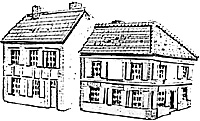 1. Buildings. One needs to decide the following:
1. Buildings. One needs to decide the following:
a. How many figures fit in? I suggest the maximum number is the ground area of the building divided by the ground area of a single base.
b. How many figures can fire out? On any one building face allow one figure to fire for every three figure base frontages of outer wall. Multiply the result by the number of stories. Mark this number on the building where it can be seen so that you do not have to pick up the building during the game! Also mark the outline of the building on the wargame table surface so that you don't move the building by mistake.
c. Define the cover offered by the building:
- Wooden/sod = soft cover
- Brick/stone/baked mud = medium cover
- Brick/stone/baked mud plus reinforced roof and loopholed = hard cover
Use this protective value to give cover against artillery fire. Say, respectively 6, 12 and 18. No casualties will be suffered until that number of hits have been scored on the building by guns of 8lb calibre or over. These protective values are not used when calculating the effect of musketry, small calibre artillery ball or canister.
d. There should always be a percentage chance of buildings catching fire from artillery fire. I suggest you use 10% for a stone house and 20% for wooden. Double these percentages if hit by shells. Once set on fire a building becomes untenable in ten minutes unless as many troops as are used to fill it are engaged in fighting the fire, and no other activity. If this happens they extinguish the fire, but the building loses two protective points. Fire fighting troops may not engage in any other activity during this time and there must, of course, be water available - say, within a hundred metres.
e. Whilst on the subject of setting fire to buildings, one can allow one figure as an arsonist in base contact to set fire to a house in ten minutes if wooden or twenty minutes if stone, provided the figure is not involved in any other activity. Halve these times if the figure is an engineer/sapper. Double all times if it is raining.
2. Troops in buildings. will obviously suffer fewer casualties than those in the open attacking them, and will retain an advantage even after the attackers have broken into the building. I suggest giving the defenders a 50% bonus in hand-to-hand fighting in unprepared positions and 100% in prepared positions. Halve these bonuses once the attacker has broken in. Prepared positions are those loopholed and otherwise strengthened. If sappers are present, loopholing, etc. takes 30 minutes, if not, an hour.
3. Troops firing out of buildings. are normally resting weapons so gain more accuracy. Give these a 10% to 20% bonus depending on your assessment of the troops firing. As an alternative this bonus could be given by allowing them a slightly longer range.
4. Attackers. Impose a limit on the number of figures that may attack the building. This can be the number of figures that can make base to base contact with the building's walls. Some rules only allow two figures to attack each facing door or window. Some rules simplify all the above by merely adding 50% to soft cover and 100% to hard cover. These ignore, for speed of play sake, all the other advantages/restrictions.
5. Morale. Men in cover will have a plus on morale. This can be anything up to 50%. However, troops in such positions hate being surrounded or bypassed. Thus morale could be a negative percentage if this occurs. One can also vary the morale bonus depending on the ratio between attackers and defenders. One can even introduce a desperation morale factor where defenders dare not surrender. An example are the Texans at the Alamo.
* Editor's note: You may know this as Military Operations in Urban Terrain (MOUT) or, as we taught in the Armor School, Combat Operations In The Urban Sprawl (COITUS).
Back to Table of Contents -- Lone Warrior #111
Back to Lone Warrior List of Issues
Back to MagWeb Magazine List
© Copyright 1995 by Solo Wargamers Association.
This article appears in MagWeb (Magazine Web) on the Internet World Wide Web.
Other military history articles and gaming articles are available at http://www.magweb.com
